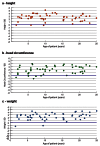The Tatton-Brown-Rahman Syndrome: A clinical study of 55 individuals with de novo constitutive DNMT3A variants
- PMID: 29900417
- PMCID: PMC5964628
- DOI: 10.12688/wellcomeopenres.14430.1
The Tatton-Brown-Rahman Syndrome: A clinical study of 55 individuals with de novo constitutive DNMT3A variants
Abstract
Tatton-Brown-Rahman syndrome (TBRS; OMIM 615879), also known as the DNMT3A-overgrowth syndrome, is an overgrowth intellectual disability syndrome first described in 2014 with a report of 13 individuals with constitutive heterozygous DNMT3A variants. Here we have undertaken a detailed clinical study of 55 individuals with de novoDNMT3A variants, including the 13 previously reported individuals. An intellectual disability and overgrowth were reported in >80% of individuals with TBRS and were designated major clinical associations. Additional frequent clinical associations (reported in 20-80% individuals) included an evolving facial appearance with low-set, heavy, horizontal eyebrows and prominent upper central incisors; joint hypermobility (74%); obesity (weight ³2SD, 67%); hypotonia (54%); behavioural/psychiatric issues (most frequently autistic spectrum disorder, 51%); kyphoscoliosis (33%) and afebrile seizures (22%). One individual was diagnosed with acute myeloid leukaemia in teenage years. Based upon the results from this study, we present our current management for individuals with TBRS.
Keywords: DNMT3A; Tatton-Brown-Rahman; intellectual disability; overgrowth.
Conflict of interest statement
No competing interests were disclosed.
Figures




References
Grants and funding
LinkOut - more resources
Full Text Sources
Other Literature Sources

